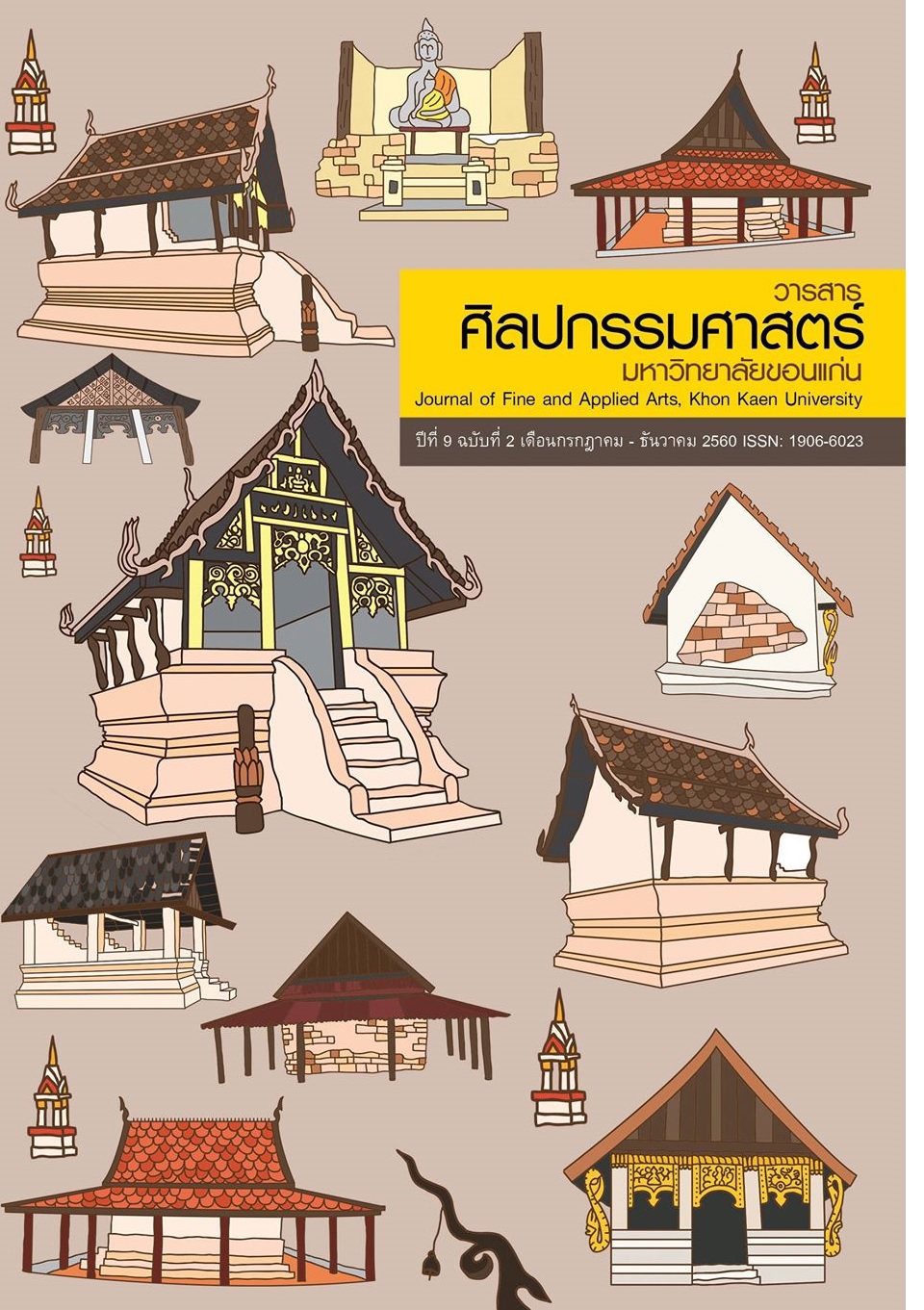วาดฟ้อนชาวไทดำในประเทศไทย: อัตลักษณ์และการเปลี่ยนแปลงภายใต้บริบทวัฒนธรรมเชิงการท่องเที่ยว กรณีศึกษาชาวไทยดำบริเวณบ้านนาป่าหนาด อำเภอเชียงคาน จังหวัดเลย
Main Article Content
บทคัดย่อ
งานวิจัยนี้ มุ่งที่จะศึกษาอัตลักษณ์และการเปลี่ยนแปลงวาดฟ้อนชาวไทดำในประเทศไทย กรณีศึกษาบ้านนาป่าหนาด อำเภอเชียงคาน จังหวัดเลย โดยมีวัตถุประสงค์การวิจัย คือ 1) เพื่อศึกษาอัตลักษณ์ในวาดฟ้อนของชาวไทยดำ 2) เพื่อศึกษาถึงการเปลี่ยนแปลงในวาดฟ้อนของชาวไทยภายใต้บริบทวัฒนธรรมเชิงการท่องเที่ยวงานวิจัยนี้เป็นการวิจัยเชิงคุณภาพ โดยใช้การลงภาคสนามในการศึกษาข้อมูลเป็นหลัก ซึ่งใช้วรรณกรรม ทั้งในประเทศและต่างประเทศ เป็นส่วนประกอบ เครื่องมือที่ใช้ในการวิจัย ได้แก่ แบบสำรวจ แบบสังเกต แบบสัมภาษณ์ และการสนทนากลุ่ม แล้วนำข้อมูลที่รวบรวมได้ทั้งหมดมาวิเคราะห์ ตรวจสอบข้อมูลทางแนวคิดด้านความเชื่อ ด้านประวัติศาสตร์ และหลักการทางด้านนาฏยศิลป์ที่สะท้อนถึงบริบทของสังคม โดยนำเสนอผลการวิจัยด้วยการพรรณนาวิเคราะห์
จากการวิจัยพบว่า ไทยดำเป็นกลุ่มชาติพันธุ์ไทยที่มีถิ่นฐานเดิมอยู่ในแคว้นสิบสองจุไท ไทดำในบริเวณบ้านนาป่าหนาด อำเภอเชียงคาน จังหวัดเลย ได้ถูกกวาดต้อนเข้ามาในประเทศไทย ตั้งแต่สมัยกรุงธนบุรีและรัตนโกสินทร์ตอนต้น วาดฟ้อนของชาวไทยดำมีความเกี่ยวพันกันกับ ลักษณะภูมิศาสตร์ ประวัติศาสตร์ วัฒนธรรมและเศรษฐกิจ ท่าฟ้อนที่พบคือ 1)ท่า เปียว 2)ท่ากันแซซ่า หรือท่าบ้ำ3) ท่าแซซ่า 4)ท่าหนุ่มสาว 5) ท่าสามัคคี 6) ท่าบ๊ายบาย เป็นท่วงท่าที่คิดขึ้นใหม่ เพื่อใช้อำลานักท่องเที่ยว 7) ท่าโด๊ง เป็นท่าสวัสดี การเปลี่ยนแปลงนี้ไม่ได้ส่งผลถึงลักษณะอัตลักษณ์ของวาดฟ้อนดั้งเดิมของชาวไทยดำมากนัก ทว่า ในด้านขนบวัฒนธรรมนั้น วาดฟ้อนที่เปลี่ยนแปลงถือได้ว่ามีความสำคัญในฐานะของการเปลี่ยนแปลงและปรับตัวของวาดฟ้อนของชาวไทยดำ ซึ่งชี้ให้เห็นถึงการเปลี่ยนแปลงใน ด้านวัตถุประสงค์ของการฟ้อนของชาวไทยดำที่แต่เดิมมีขึ้นเพื่อใช้ในพิธีกรรมแต่ถูกเปลี่ยนแปลงไปเพื่อรองรับการท่องเที่ยว ซึ่งทำให้ระบบสังคมและวัฒนธรรมความคิด และความเชื่อ ของชาวไทยดำเปลี่ยนแปลงไป
This research was aimed to study the identity and changes of the dancing postures of Thai Dum ethnic in Thailand by the case study of Na Pa Nhad Village in Chiangkan District, Loei Province. The objectives of the study were to study the identity of Thai Dum’s dance postures and to study changes of the dance postures of Thai Dum in the tourism culture context. This research was the qualitative research mainly employing field study to collect data. The literature used were both Thai and International. The research tools were survey form, observation form, interview form, and focused group conversation. The data collected were analyzed and checked regarding values, history and principles of performing arts which mirrored social context. The research result was presented by descriptive analysis.
The research revealed that Thai Dum was a Thai ethnic group originally resided in Sibsong Jutai Region. Thai Dum in Na Pa Nhad Village, Chiangkan District, Loei Province was moved into Thailand since Thonburi and early Rattanakosin Era. Dance postures of Thai Dum were related to geography, history, culture, and economy. The found postures were 1) Peaw Posture, 2) Kansaesa or Bum Posture, 3) Saesa Posture, 4) Noomsao Posture, 5) Samukki Posture, 6) Baibai Posture which was newly invented to farewell tourists, and 7) Dong Posture which was the greeting posture. The changes did not very much affect the identity of the original Thai Dum dance postures. However, in traditional and cultural terms, the changing dance postures were significant as the changes and adaptation of the dance postures of Thai Dum which signified changes from original objectives of Thai Dum Dance. The dance was originally used in ritual and was now used to promote tourism. This drove the system in society, culture, ideology, and value of Thai Dum to change.
Article Details
เนื้อหาและข้อมูลในบทความที่ลงตีพิมพ์ในวารสารคณะศิลปกรรมศาสตร์ มหาวิทยาลัยขอนแก่น ถือเป็นความคิดเห็นและความรับผิดชอบของผู้เขียนบทความโดยตรง ซึ่งกองบรรณาธิการไม่จำเป็นต้องเห็นด้วย หรือร่วมรับผิดชอบใด ๆ
บทความ ข้อมูล เนื้อหา รูปภาพ ฯลฯ ที่ได้รับการตีพิมพ์ในวารสารคณะศิลปกรรมศาสตร์ มหาวิทยาลัยขอนแก่น ถือเป็นลิขสิทธิ์ของวารสารคณะศิลปกรรมศาสตร์ มหาวิทยาลัยขอนแก่น หากบุคคลหรือหน่วยงานใดต้องการนำทั้งหมดหรือส่วนหนึ่งส่วนใดไปเผยแพร่ต่อหรือเพื่อกระทำการใด ๆ จะต้องได้รับอนุญาตเป็นลายลักอักษรจากวารสารคณะศิลปกรรมศาสตร์ มหาวิทยาลัยขอนแก่น ก่อนเท่านั้น


